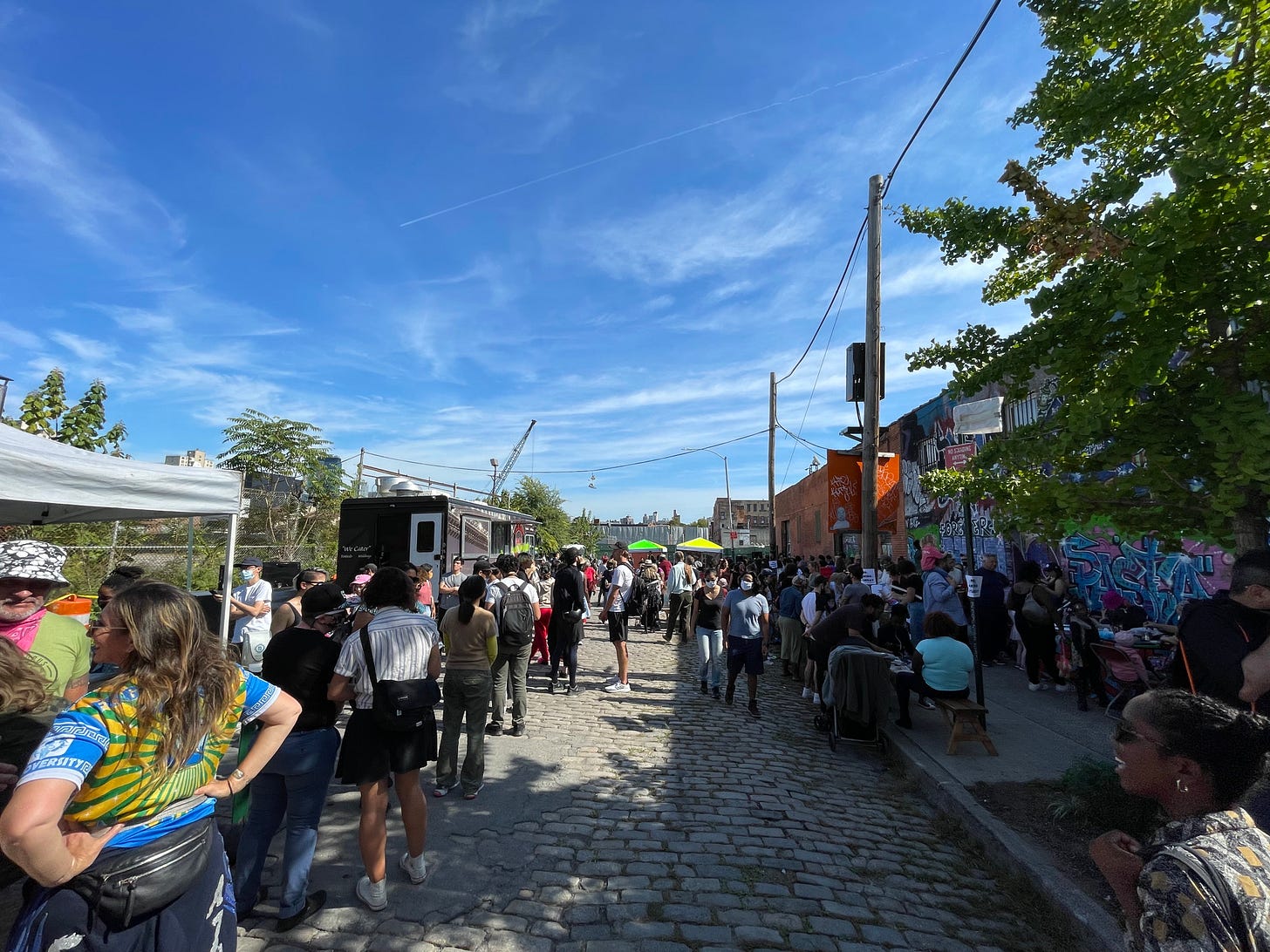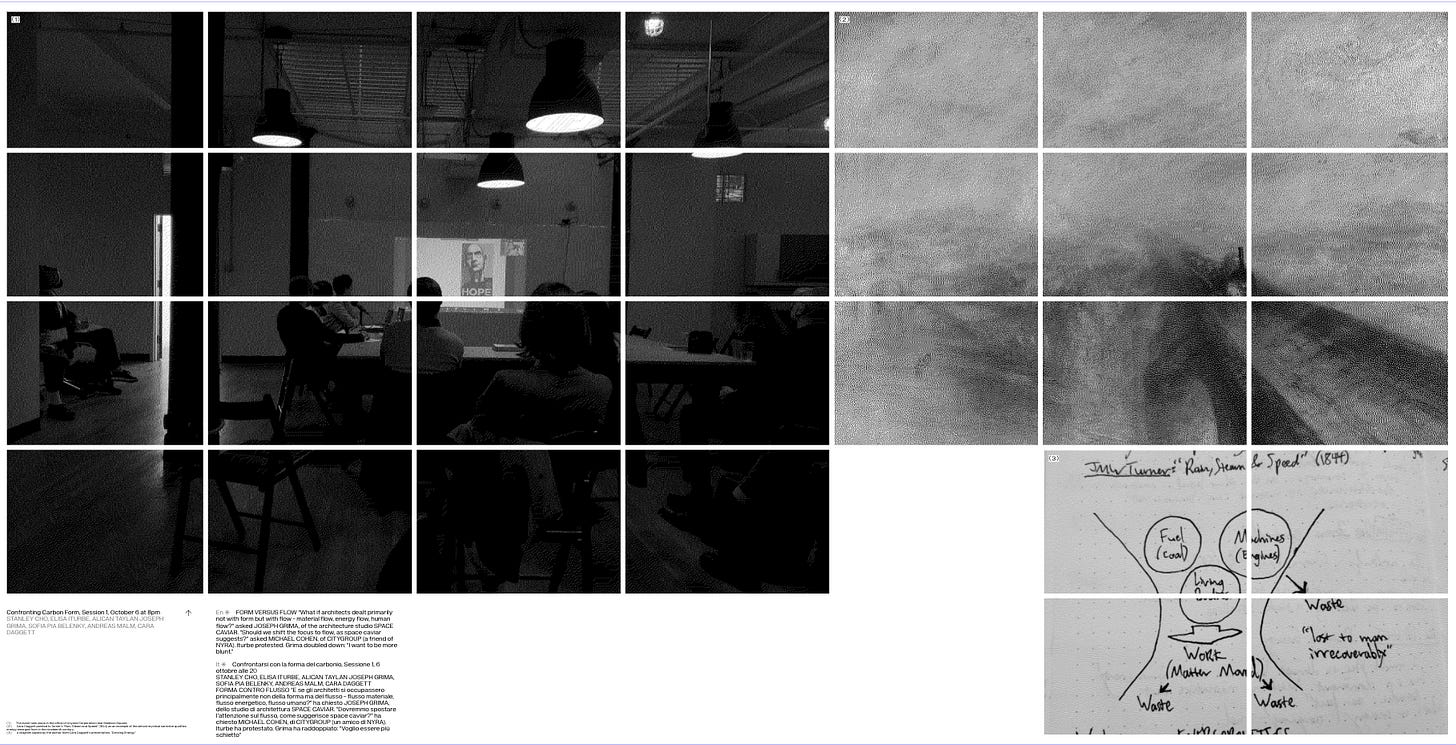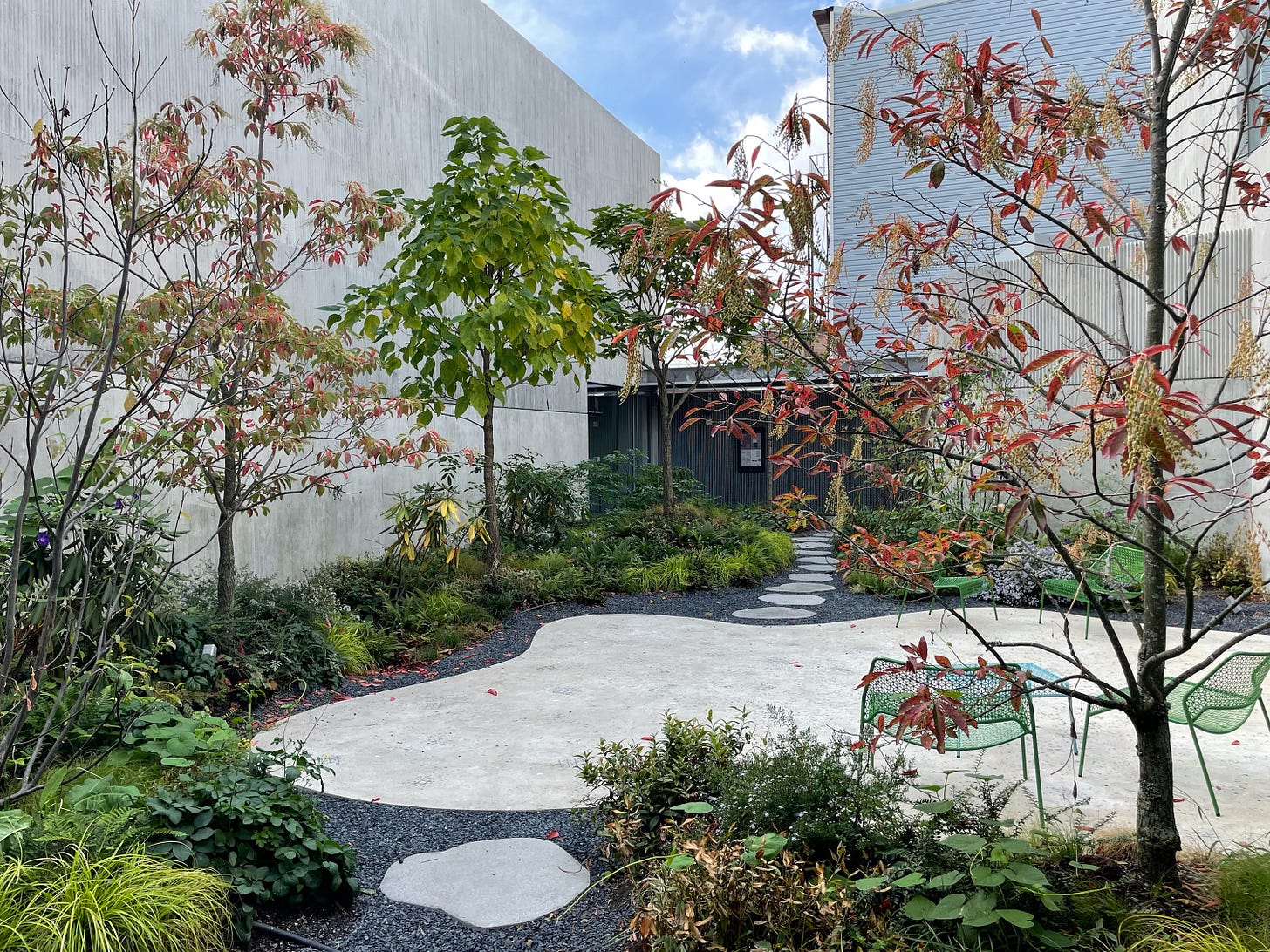S K Y L I N E | 40 | Making Strides
This week it's all about making improvements and getting out there
Welcome! If someone forwarded you SKYLINE, sign up here to receive it weekly.
Good morning, Skyline Readers!
It’s been a busy week in the design world. With Archtober (of which NYRA is a media partner) and the fall semester underway, in-person events are all the rage. This week we have dispatches from five writers, almost all of whom attended an event the old-fashioned way. Everything from the mechanics of membrane architecture, to Afrofuturism, to the real nature of energy is discussed in this issue of Skyline. We also feature our first Archtober Building of the Day coverage, which we hope will inspire you to go out and see some of the new builds and renovations this city has been slowly but surely completing despite all the chaos of the last year-and-a-half for yourself.
With that, read on!
DISPATCHES
9/30: Membrane Mechanics
In the U.S., the construction industry faces a crisis. Declining labor productivity, depleted natural resources, and wasteful disposal practices have all contributed to a built environment that is outdated, inefficient, and feeble. Like so many other others around the country, the A/E/C industry’s old M.O. is no longer viable.
SIGRID ADRIAENSSENS, an associate professor at Princeton University, proposed a new way of construction at her recent lecture, “Harnessing Extraordinary Mechanics for Structural Design”, held at MIT. Her work interrogates what we design for, how we design, and how we build. These fundamental questions allow her to reformulate structural methods in construction; her focus is on slender surfaces with extreme loading that are designed using geometry and mechanics through a self-assembly process. Her framework pilots new materials, minimal material usage and energy requirements, and efficient methods of construction.
“We are really going to need [these interventions] because we are facing huge challenges; we need more floor space, we have much bigger loadings, and we don't want to create any waste when we are building,” says Adriaenssens. Simply put: “We need to change.”
Adriaenssens draws inspiration from myriad trades and areas of study. She has worked closely with craftsmen, lace makers, artistic dancers, and botanists. “We look to biology, craft, and history to inspire new structural systems that maybe haven't been studied before. In order to do that, we developed numerical, machine learning, graphical, and fluid structure interaction models to generate knowledge in this domain,” explains Adriaenssens. Her work—lightweight, “membrane” structures with many load paths—awakens an underlying poetry in the way structures perform and activate their environment.
These new methods and practices present possibilities for a constructed environment tuned not only for its current function, but the impact during construction, after construction, and into the distant future. In an industry that relies on typological traditions and construction methods that compromise their ability to continue into the not-so-distant future, Adriaenssens navigates towards flexibility, resiliency, and strength.—CHRISTIAN MALDONADO
10/1: Center for Architecture Reopens
The Center for Architecture opened their doors for the first time in 18 months last Friday, kicking off Archtober with two exhibitions: Cairo Modern and the AIANY Design Awards 2020 & 2021. From 4-8pm, the Center was stuffed; people and drinks flowed throughout all three floors. The party eventually spilled onto the street, with guests exchanging thoughts, stories, and occasionally business cards. Professional society is healing.—NICHOLAS RAAP
10/2: Block Party in South Brooklyn

In December 2019, the VAN ALEN INSTITUTE decamped from its longtime Flatiron home to the fast-transforming banks of Brooklyn’s Gowanus Canal. The onset of the pandemic a few months later put their usual programming on hold, including a proper public introduction to the neighborhood.
The Van Alen Block Party hosted on Saturday—nearly two years after the move—brought that much-anticipated fête to a close. There, on the cobble-stone, dead-end intersection of Bond St. and Sackett St., stakeholders from across the neighborhood converged to celebrate the last gasp of summer. Several local dance troupes and bands, such as the Gowanus Wildcats Drill Team and La Cumbiamba eNeYé, as well as DJs Niara Sterling and Scribe, kept the party going. To the side, Brooklyn-based artist Elijah Anderson painted a large-scale, doodle-style artwork with the help of partygoers; and local groups Gowanus Mutual Aid and the Mechanical Gardens Bike Co-op made themselves known to passersby.—MATTHEW MARANI
10/4: Skyrise for Harlem
"Architecture is the European art of building...it projects the future, it claims the future...it does not do well with the present at all," said Columbia professor and architect MABEL O. WILSON at a lunchtime gathering moderated by LEIGH RAIFORD, a professor of African American Studies at Berkeley, to discuss the poet, activist and sometimes architect JUNE JORDAN. "Jordan, by contrast, is about the now and how to build the future in relationship to it."
According to a 2020 New Yorker piece by Claire Schwartz, after a July 1964 police shooting led to six nights of uprisings in Harlem and Bedford-Stuyvesant, Jordan found herself full of "hatred for everything and everyone white." She nevertheless forced herself to focus not on her hatred, but on what she loved. This led Jordan to team up with Buckminster Fuller to propose a redesign for Harlem: a series of giant conical towers, with ample room for housing, schools, and other public facilities.

While aspects of the plan—the focus on cars (including spiraling highway ramps)—are dated, the plan's ingenuity was that it was incremental; the supporting struts for the cones would rest in backyards, so as not to demolish a single existing building. It was designed with time in mind.
This story—a Black woman trying to use architecture to meet her community's pressing needs with a sensitive but bold approach—disappeared when Esquire Magazine changed the scheme's headline from Jordan's suggested "SKYRISE FOR HARLEM" to "INSTANT SLUM CLEARANCE", with only Buckminster Fuller credited as its author.
Jordan is now back, joined by key voices in the Afrofuturism and Speculative Urbanism communities. Artist and architect OLALEKAN JEYIFOUS shared work he had recently exhibited as part of MoMA's Reconstructions exhibit, "The Frozen Neighborhoods." BRANDI SUMMERS, of the Berkeley Lab for Speculative Urbanism, shared a set of projects addressing the diminishing Black population in Oakland, California (the Oakland Museum of Contemporary Art also has an exhibit on the topic, Mothership: Voyage Into Afrofuturism). Both Jeyifous and Summers came back to Wilson's skepticism about architecture's European origins: "It is about an imperial, colonial agenda that will go forth, clearing land... [and achieving] dominion over the natural environment," said Jeyifous.
All of the participants look to Jordan as proof that there is another way—and her mistreatment as proof that this way has always been there, just ignored or suppressed. Said Summers, "Black world making happens all the time."—NICOLAS KEMPER
10/6: Form Versus Flow

"What if architects dealt primarily not with form but with flow—material flow, energy flow, human flow?" asked JOSEPH GRIMA, of the architecture studio SPACE CAVIAR, in the first session of Confronting Carbon Form, a five part series organized by the architecture journal LOG and hosted by STANLEY CHO, ELISA ITURBE, and ALICAN TAYLAN. It builds on an issue of Log guest edited by Iturbe in 2019, “Overcoming Carbon Form”, that effectively attempted to move the discussion around climate change away from sustainability (a word she avoids, because it would suggest we want to sustain the status quo) and into form. But form, too, has its own baggage.
"Should we shift the focus from form to flow, as Space Caviar suggests?" later asked MICHAEL COHEN, of citygroup. Iturbe protested. Grima doubled down. After the Second World War, he explained, "Architecture became relegated to the production of form." Today, Grima went on, the profession mainly concerns itself with "the decoration of trophy buildings."
In her presentation, SOFIA PIA BELENKY, a partner of Grima's at Space Caviar, showed how flow plays out in their current project, "NON-EXTRACTIVE ARCHITECTURE," at their year-long installation at the Palazzo Zattere: The installation keeps installing itself throughout the year. As more research is done, a software widget (the Exhibition Format Editor) allows the researchers to plug in photos and churn out wall-sized displays. Those walls, in turn, become the pages of their next book.
The final presenter, Professor CARA DAGGETT of Virginia Tech, coiner of the term "petro-masculinity," and author of the book The Birth of Energy, gave a smashingly good presentation on, well, energy. The painter William Turner was involved. The three myths of energy:
Myth #1: It is timeless—NOPE! It was born out of nineteenth-century thermodynamics.
Myth #2: Energy is universal—NOPE! We learned about energy so we could optimize fossil fuel burning steam engines.
Myth #3: Physics knows what energy is—NOPE! Energy is not a thing, it is a set of equations, and theoretical physicians sometimes fudge or ignore it (or to quote Nobel Laureate Percy Bridgman, energy is "a mysterious epistemology, not a hard fact.").
What does all of this have to do with architecture, or form for that matter? Daggett could not quite say—her preferred target are engineers: "Energy, work, and freedom are bound together, and ratified by modern engineering." Buy the book. I definitely just did.
The second presenter, ANDREAS MALM, came by way of a choppy pre-recorded interview, but probably posed the question closest to the heart of the series. After arguing that fossil fuel extraction is bound up with the rise of capital, he asked: "What do we do with this enormous energy infrastructure that has to be dismantled?"—NICOLAS KEMPER
10/7: Building of the Day: Amant Foundation

Nestled between auto-body shops and industrial warehouses in East Williamsburg, the Amant Foundation’s new arts campus is a hidden gem worth braving the L train to see. Designed by SO-IL, the three buildings that make up the campus stretch across three blocks (21,000 sq. in area)—not an insignificant footprint for a young, independently-owned, non-collecting institution and artist residency. Its size may be large on paper, but in person the campus still feels contained and private, almost mysterious in how unobtrusive it is.
That sense of poised mystery is best articulated through Amant’s materiality, with particular praise directed to its facade. Brick, cast-in-place concrete, aluminum, and steel echo the site’s context and history without coming across as glib (a rare feat in today’s architectural paradigm). The colors are muted, sticking to a solidly neutral palette of whites, grays, beiges, and browns. The most impressive moment of visual and tactile surprise is the cement brick facade, where a dogtooth pattern alternates the smooth and rough sides of the bricks. The effect is an almost irresistible desire to touch the building, to want to know it on a deeper level.
Although technically Amant Foundation opened in July, SO-IL is still putting on the finishing touches. This precluded our tour from seeing some of the interior spaces, like the artists’ studios and lounges, the offices, and the coming-soon cafe. Once the project is totally wrapped up, Amant’s draw and vibe could echo Dia: Beacon’s and would cost significantly less time and money to access. In short, a must-see.—ANNA GIBERTINI
HOUSEKEEPING
Last week we gathered at citygroup to eat dumplings, toast our subscribers, and put more than six hundred copies of issue #22 in the mail. It has rats on it.
Support our contributors and subscribe, and we will happily put one more in the mail for you.
EYES ON SKYLINE
(most clicked links from skyline 39)
Last week, readers were particularly impressed with the web design for two upcoming events: postcommodities…architecture after stuff (10/8-9, University of Michigan) and Black in Design Conference 2021 (10/8-10, Harvard GSD).
IN THE NEWS…
…The newly renovated lobby at 550 Madison, New York’s most-famed Postmodernist skyscraper, was unveiled for the first time.
…Once again the Danes excel at sensible, sustainable design, transforming retired wind turbine blades into footbridges and bicycle garages.
…There is some drama happening at Princeton University surrounding former professor Alejandro Zaera-Polo’s ouster and his polemical response.
…Eames heads can now take their favorite designers with them wherever they go with the new Reebok x Eames Club C Collection trainers.
DATELINE
The week ahead…
Friday, 10/8
Black in Design Conference: Black Matter with Tomi Laja, Caleb Negash, Somala Diby, Tosin Odugbemi, Wanjiku Ngare, Nicholas Gray (October 8-10)
12:00 PM | Harvard GSD African American Student Union
Beirut: From Emergency Patchwork to the Long Term with Richard Plunz, Victor Body-Lawson
1:00 PM | GSAPP Collective for Beirut
postcommodities…architecture after stuff Symposium with Laida Aguirre, Nicholas Korody, Michael Wang, Heather Davis, Keller Easterling, Ann Lui, Postnatural Studies Institute, New Affiliates, Seetal Solanki, Jack Halberstam, Meredith Miller
7:00 PM | University of Michigan Taubman College of Architecture
Saturday, 10/9
Art & Object Walk at Brooklyn Navy Yard with Carli Beseau
11:30 AM | Brooklyn Navy Yard Center at BLDG 92
Monday, 10/11
Non-human Centered Architecture with Boonserm Premthada, Andrés Jaque
6:00 PM | GSAPP
Tuesday, 10/12
Travel To: Young & Ayata in Mexico City with Kutan Ayata, Michael Young
12:00 PM | Center for Architecture
Wednesday, 10/13
AT THE CROSSROADS OF TURK AND TAYLOR: REMEMBERING LEGACIES OF OPPOSITION TO CARCERAL POWER IN SAN FRANCISCO'S TENDERLOIN DISTRICT
1:00 PM | UC Berkeley
Global Futures: Transitions In Urban Paradigms
5:00 PM | New York Institute of Technology
Florian Idenburg: Strings Attached
10:00 PM | SCI-ARC
Thursday, 10/14
Building of the Day Tour: Saint Marks Place, Brooklyn
12:00 PM | Center for Architecture
Conversations on Care with Mpho Matsipa
6:00 PM | MIT
OVERHEATED: HOW CAPITALISM BROKE THE PLANET–AND HOW WE FIGHT BACK
6:30 PM | GSAAP
Friday, 10/15
Building of the Day Tour: Hauser & Wirth 22nd Street
12:00 PM | Center for Architecture
For the complete list and future weeks, visit: nyra.nyc/events
Have an event we missed? Submit the details here.
LETTERS TO THE EDITOR
Would you like to share your thoughts? Please write to us. Simply reply to this e-mail or write to us at editor@nyra.nyc.
Four desk editors run NYRA: Alex Klimoski, Phillip Denny, Carolyn Bailey & Nicolas Kemper (who also serves as the publisher). They rotate duties each month.
To pitch us an article or ask us a question, write to us at: editor@nyra.nyc.
For their support, we would like to thank the Graham Foundation and our issue sponsors, Tod Williams Billie Tsien Architects and Thomas Phifer.
To support our contributors and receive the Review by post, subscribe here.




